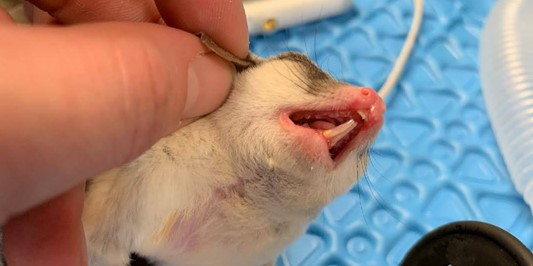
Pet Dental Month: Exotic Small Mammal Dental Awareness
It is National Pet Dental Health Month, so we want to be sure you are aware that exotic small mammals have dental health care needs too!
Small mammals such as rabbits, rats, chinchillas, ferrets, guinea pigs, sugar gliders, and hedgehogsall have mouths that might need supportive care throughout their lifetime just like other animals. The average lifespan of these wonderful companions has increased through the years with the increase of preventive medicine and yearly examinations. Before performing an annual physical examination on these little guys, we obtain a thorough history and review diet as well as feeding habits. The reason we harp on asking owners husbandry questions on their pet’s annual wellness exams is so we can both reflect on what is being offered vs what they are actually eating. Certain species of small mammals can have dental disease issues from an inappropriate diet or simply not eating the appropriate diet that is offered.
What can dental disease look like in exotic small mammals?
Dental disease is a complete syndrome and can produce a wide range of clinical signs and symptoms. Some signs might include reduced food intake, weight loss, altered appetite/eating behaviors, difficulty swallowing, or changes in fecal quantity and size. Complications associated with dental disease can appear as excessive grooming, excessive salivation/drooling, facial abscesses, watery eyes, bulging eyes, nasal discharge, or difficulty breathing. Other signs and symptoms that may be secondary to dental disease include poor overall condition, gastrointestinal problems, poor coat health, eye diseases, or even sudden death.
Guinea pigs also get a special kind of dental disease when their teeth are overgrown and traps their tongue underneath known as tongue entrapment. The tongue needs to be able to elevate for them to swallow their food, so not only do they have trouble chewing their food, but they are unable to swallow it as well.
Small mammals are considered prey species and are therefore exceptionally good at hiding their diseases. This makes a thorough clinical history all the more important. Reduced food intake and abnormal feces in rabbits and rodents are common early symptoms that might be missed by owners. A thick hair coat can hide evident signs of weight loss or the presence of facial swellings. An effective way to stay ahead of these sneaky critters is to weigh the animal on a scale regularly (at the same time every day) paying close attention to the normal trends of the pet’s weight. With the small body mass of exotic species, a postage or kitchen scale is a terrific way to get recurring accurate weights.
All small mammals are at risk of developing dental disease during their lifetime- this is most notable in the rabbit and guinea pig. Despite our best efforts for nutritional education, many are still not getting the appropriate fiber intake they need to adequately wear down their teeth. When the cheek teeth grow abnormally, they cannot move their jaw to chew their food appropriately. Often the rabbit will reject hay and look for food that is easier to crush thus further reducing the proper chewing motion to keep the continuously growing teeth at an appropriate length and shape.
What does a physical oral examination of an exotic small mammal look like?
All small mammals require proper restraint to allow the doctor to feel along the upper and lower jaw including around the patient’s eye sockets. The goal is to detect any bony irregularities or swellings that can be caused by elongation of the patient’s cheek teeth or even abscesses. The eyes are examined for symmetry as well as eye ducts for patency. Next, the incisors are inspected from the front as well as the side profiles. The doctor also evaluates the mobility of how the jaw moves thereby inspecting how the check teeth move within the mouth. A speculum with a light source is used within their mouth to check for spurs, elongated crowns, or oral ulcerations.
Often when ferrets are restrained, they will open their mouths up wide to yawn, and then we can get a good look at their oral cavity without a mouth speculum. We pay special attention to the molars that are usually covered by the lips and are difficult to visualize. Ferrets might be presented to veterinary staff for chewing problems, but apart from advanced dental disease, they rarely show clear symptoms of dental disease. Our annual exams always include the oral cavity of all species.
What do normal rabbit teeth look like?
The oral cavity of the rabbit is long and narrow. They have two pairs of upper incisors- one set is longer and chisel-shaped, and the second set is shorter and peg-shaped. They have one set of lower incisors that are chiseled shaped. There is a significant gap without any teeth before their cheek teeth start. They technically have a total of twenty-two premolars and molars, but they are grouped together and simply called cheek teeth. Rabbit teeth have long crowns that continuously grow throughout their lifetime (called “hypsodont”). The function of the incisors is to cut grass and other plants. The food is then chewed with the rough surface of their cheek teeth. Rabbits will use mandibular movements in three directions to pulverize their food. This way of eating fibrous foods (such as hay) helps to wear down their continuously growing teeth to an appropriate and comfortable length.
What do normal guinea pig, chinchilla, and rat/mouse teeth look like?
The mouth of a guinea pig, chinchilla, and rat/mouth is remarkably similar to that of the rabbit. Their mouth is exceptionally long and narrow. All of these species have upper and lower incisors with a gap of no teeth (diastema) and then premolars and molars. Guinea pigs and chinchillas have twenty teeth in total and rats/mice have sixteen teeth. Like the rabbit, these species have teeth that continually grow throughout their lifetime. It is extremely important to be sure these species are on the appropriate diet.
Rabbits, guinea pigs, and chinchillas should be offered unlimited quantities of hay and a small amount of fresh vegetables. Rabbits should be offered ¼ cup of pellets per 5lbs body weight. Guinea pigs do not produce their own vitamin C, so it needs to be supplemented by an outside dietary source. Some examples would be dark leafy greens such as kale, collard greens, mustard greens, or even dandelion greens. About ½ to 1/3 cup of vitamin C-rich foods need to be eaten each day to ensure they are receiving the appropriate amount of vitamin C. Chinchillas can get a small amount (1-2 tablespoons) of rabbit or chinchilla pellets. Chinchillas should not have more than one teaspoon of fresh vegetables, dried fruit, or raisins. No small mammals should ever be fed a mix containing pellets/seeds/dried fruits as they will selectively pick out the high-calorie objects.
Rats and mice should get pellets formulated for their species.
What do normal ferret, hedgehog, and sugar glider teeth look like?
Ferrets and hedgehog species both have a total of thirty-four teeth. The most common dental issue that ferrets and hedgehogs can get are dental tartar, gingivitis, and dental decay. Unfortunately, hedgehogs are also prone to mouth cancer as well.
Ferrets should be fed a ferret-specific diet. Most of these diets are in kibble form but sometimes they can also have canned kitten food. Dry kibble or raw meat is the best diet for keeping your ferrets’ teeth clean however see your veterinarian before deciding to switch to a raw diet. Hedgehogs eat mostly insects and a high-quality reduced calorie cat food along with a small amount of fresh vegetables and fruits. Regular brushing can help to control tartar but many ferrets and hedgehogs resist the practice of owners brushing their teeth. Most commonly after 2 years old, an annual dental cleaning is done under gas anesthesia with x-rays taken to check for dental disease. Their teeth do not continue to grow throughout their life like guinea pigs, chinchillas, rats, and mice.
Sugar gliders have forty teeth in total. They have two upper incisors & two much longer lower incisors that point forward. They also have canine teeth, premolars, and molars to make up their dental form. They use their teeth to scoop out the fruit and pry open tree bark to access sap and insects. Their diet in the wild is mainly one of insects, gum, sap, nectar, and pollen. Their daily diet in domestication should be approximately 15-20% of their body weight and include the following three components of pelleted kibble, calcium-based multivitamin, washed fruits/vegetables, and gut-loaded insects on rare occasions as treats.
Do small mammal pets need help with dental care?
Yes, small mammal exotic pets have dental health care needs too. A proper diet can play a major role in dental care for these species. An annual exam is important for the overall health of all pets. If you suspect issues, don’t wait for your pet’s annual exam to reach out to your veterinarian. If you have any questions or concerns about your exotic pet, Brook-Falls is here to help. Please call our office to schedule an appointment.
Resources:
Rabbit and Rodent Small Mammal Dentistry Chapter 32
vetcentral.com.sg/blogs/news/dental-disease-in-guinea-pigs
VeterinaryParnter.com
